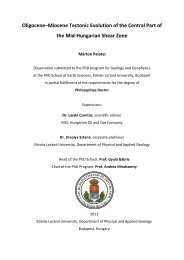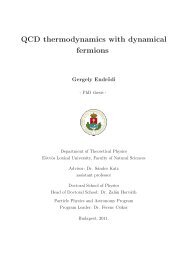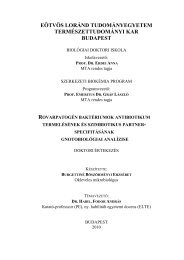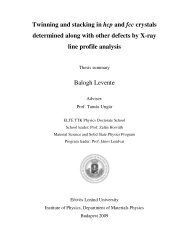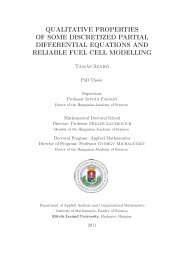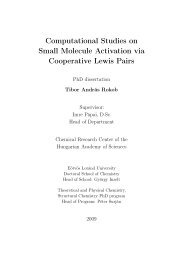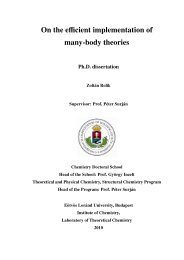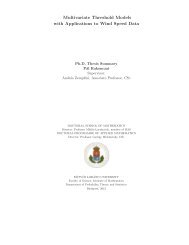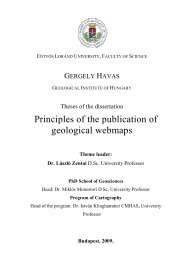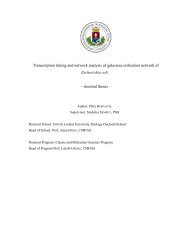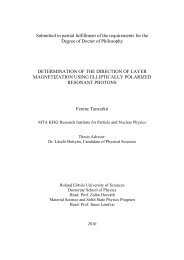Synthesis and application of new fluorinated ... - ELTE TTK TEO
Synthesis and application of new fluorinated ... - ELTE TTK TEO
Synthesis and application of new fluorinated ... - ELTE TTK TEO
You also want an ePaper? Increase the reach of your titles
YUMPU automatically turns print PDFs into web optimized ePapers that Google loves.
<strong>Synthesis</strong> <strong>and</strong> <strong>application</strong> <strong>of</strong> <strong>new</strong><br />
<strong>fluorinated</strong> building blocks<br />
Anikó Nemes<br />
Supervisor: Dr. Dénes Szabó, C. Sc., Associate Pr<strong>of</strong>essor<br />
Thesis<br />
Eötvös Loránd University, Chemistry Doctoral School<br />
Head: Dr. György Inzelt, D. Sc., Pr<strong>of</strong>essor <strong>of</strong> Chemistry<br />
Synthetic Chemistry, Materials Science <strong>and</strong> Biomolecular Chemistry Program<br />
Head: Dr. András Perczel, D. Sc, Pr<strong>of</strong>essor <strong>of</strong> Chemistry<br />
<strong>ELTE</strong>, Faculty <strong>of</strong> Science, Institude <strong>of</strong> Chemistry,<br />
Department <strong>of</strong> Organic Chemistry<br />
Budapest, 2010
I. Introduction<br />
The synthesis <strong>of</strong> an organic compound in the laboratory usually involves several steps. First a<br />
chemical reaction is performed which then followed by the isolation <strong>of</strong> the target compound.<br />
Consequently the effectiveness <strong>of</strong> a chemical synthesis is determined not only by the<br />
conversion <strong>of</strong> the chemical reaction but with the effectiveness <strong>of</strong> the isolation <strong>of</strong> the target<br />
compounds as well. Thus, synthetic chemistry calls for both the use <strong>of</strong> safe <strong>and</strong> effective<br />
reactions <strong>and</strong> easy product isolation techniques.<br />
One <strong>of</strong> the key issues for designing a chemical synthesis is the selection <strong>of</strong> the reaction which<br />
assures high product selectivity <strong>and</strong> yield, perhaps using a catalytic system. Environmental<br />
effects should also be considered at this stage to eliminate or diminish all risks associated with<br />
the use <strong>of</strong> the reaction components, reagents <strong>and</strong> solvents. Moreover, ideal product isolation<br />
strategy requires the purposeful setting <strong>of</strong> the phase properties <strong>of</strong> all involved reaction<br />
components to achieve product isolation by the use <strong>of</strong> simple separation techniques, such as<br />
extraction, evaporation or filtration.<br />
A simple strategy for product isolation employs orthogonal (=immiscible) phases, such as<br />
solid-liquid, gas-liquid <strong>and</strong>/or liquid/liquid. Fluorous biphasic catalysis 1 allows easy product<br />
separation <strong>and</strong> catalyst recovery, which exploits the unique physico-chemical properties <strong>of</strong> the<br />
perfluoroalkanes, <strong>and</strong> similar so called fluorous solvents, has been introduced by Hungarian<br />
researchers (1994). Somewhat later <strong>new</strong>er fluorous techniques appeared, such as “light<br />
fluorous synthesis”, 2 fluorous solid phase extraction (F-SPE), 3 fluorous mixture synthesis,<br />
along with the fluorous versions <strong>of</strong> already known biotechnological processes (adsorption<br />
studies, proteomics, <strong>and</strong> microarraying). 4<br />
My PhD work is related to the above topics. The goal <strong>of</strong> this research included the extension<br />
<strong>of</strong> the <strong>application</strong> <strong>of</strong> fluorous compounds in synthetic organic chemistry. Here I disclose three<br />
different fields <strong>of</strong> this subject. First I synthesized optically active 1-phenyl-ethylamines with<br />
fluorous chains, <strong>and</strong> tested these compounds in the resolution <strong>of</strong> a chiral sulfoxide carboxylic<br />
acid. In the second part I introduce the synthesis <strong>and</strong> <strong>application</strong> <strong>of</strong> <strong>new</strong> types <strong>of</strong> fluorous<br />
1 I. T. Horváth, J. Rábai, Science, 1994, 266, 72-75.<br />
2 (a) D. P. Curran, Z. Luo, J. Am. Chem. Soc., 1999, 121, 9069-9072; (b) W. Zhang, Z. Luo, D. P. Curran, J.<br />
Org. Chem., 2000, 65, 8866-8873.<br />
3 W. Zhang, D. P. Curran, Tetrahedron, 2006, 62, 11837-11865.<br />
4 (a) K.-S. Ko, A. Jaipuri, N. L. Pohl, J. Am. Chem. Soc., 2005, 127, 13162-13163; (b) A. J. Vegas, J. E.<br />
Bradner, W. Tang, O. M. McPherson, E. F. Greenberg, A. N. Koehler, S. L. Schreiber, Angew. Chem. Int. Ed.,<br />
2007, 46, 1-6.
eagents. In the third part I demonstrate the syntheses <strong>of</strong> two optically active carboxylic acids<br />
which were applicable in the enantiomeric excess determination <strong>of</strong> amines with 1 H <strong>and</strong> 19 F<br />
NMR measurements.<br />
II. Results<br />
1. In the first part <strong>of</strong> my thesis I synthesized optically active fluorous 1-phenylethylamine<br />
derivatives (7-12), which are useable compounds as resolvating agents,<br />
catalyst lig<strong>and</strong>s 5 <strong>and</strong> chiral auxiliaries. The fluorous chains are attached to the<br />
molecule with the alkylation <strong>of</strong> the amine group. The strong negative inductive<br />
effect <strong>of</strong> the fluorous chains has influence on the properties <strong>of</strong> different functional<br />
group <strong>of</strong> the molecule. Because <strong>of</strong> this fact methylene groups are inserted between<br />
the nitrogen atom <strong>and</strong> the per<strong>fluorinated</strong> moiety. The modified compounds contains<br />
longer, normal perfluorooctyl chain or bulky perfluoro-tert-butyl group. The first<br />
was attached using 3-(perfluorooctyl)propyl iodide (13) reagent, 6 latter with using<br />
2-(perfluoro-tert-butyloxy)ethyl tosylate (15), 7 that compound was published earlier<br />
by our group. The fluorous compounds were synthesized in racemic, (S)-(-)- <strong>and</strong><br />
(R)-(+)- form.<br />
5 H. Klejn, A. W. Kliej, J. J. M. De Pater, M. Lutz, A. L. Spek, J. T. B. H. Jastrzebski, B.-J. Deelman, G. Van<br />
Koeten, Inorg. Chim. Act., 2005, 2674-2682.<br />
6 D. P. Curran, J. G. Gladysz, I. T. Horváth (Eds.), H<strong>and</strong>book <strong>of</strong> Fluorous Chemistry, 2003, Wiley-VCH,<br />
Weinheim, pp. 421-422. (J. Rábai, I. Kövesdi, A.-M. Bonto)<br />
7 D. Szabó, J. Mohl, A.-M. Bálint, A. Bodor, J. Rábai, J. Fluorine Chem., 2006, 127, 1496-1504.
Compounds 7-12 was tested as a resolving agent. The reaction <strong>of</strong> the racemic sulfoxide<br />
(17) 8 with (S)-(-)-7 resulted in the formation <strong>of</strong> crystalline precipitate <strong>and</strong> partial<br />
resolution <strong>of</strong> (±)-17.<br />
8 (a) D. Szabó, Sz. Szendeffy, I. Kapovits, Á. Kucsman, Gy. Argay, A. Kálmán, L. Párkányi, Tetrahedron Asy.,<br />
1997, 8, 2403-2410; (b) D. Szabó, I. Kapovits, Gy. Argay, M. Czugler, A. Kálmán, T. Koritsánszky, J. Chem.<br />
Soc., Perkin Trans. 2, 1997, 1045-1053; (c) T. Ádám, F. Ruff, I. Kapovits, D. Szabó, Á. Kucsman, J. Chem.<br />
Soc., Perkin Trans. 2, 1998, 1269-1275.
2. In the second part in my thesis, I synthesized a <strong>new</strong> type <strong>of</strong> fluorous reagents, with<br />
reactive functional groups. These compounds are easily applicable as fluorous<br />
building blocks or phase tagging reagents. The phase tagging reagents ideally have a<br />
molecular weight as low as possible. Our goal was to transform fluorous chemistry<br />
environmentally more friendly by replacing the “classical” longer fluorous ponytails<br />
(CnF2n+1, n ≥ 7) with “CF3-rich” building blocks. Since that time as the persistence<br />
<strong>and</strong> bioaccumulation problems associated with longer perfluoroalkanes <strong>and</strong> their<br />
functional derivatives (e.g. C 8 F 17 SO 3 H <strong>and</strong> C 7 F 15 COOH) became evident.<br />
Bis(polyfluoroalkoxy)isopropyl alcohol intermediates are formed when<br />
poly<strong>fluorinated</strong> alcohols are treated with epichlorohydrin in the presence <strong>of</strong> NaOH<br />
<strong>and</strong> the alcohol was converted to mesylate on purpose to build in nitrogen or sulfur<br />
containing functional groups. For testing the reactivity <strong>of</strong> ‟CF 3 -rich‟ mesylates<br />
19a-c, we selected strong <strong>and</strong> s<strong>of</strong>t nucleophiles such as azide, thioacetate, <strong>and</strong><br />
imidazole. We were also interested in the comparison <strong>of</strong> the substitution patterns<br />
with a similar alkylating agent, but having the leaving group in a primary position.<br />
Thus, (perfluoro-tert-butyloxy)ethyl tosylate (15) included here as a reference<br />
compound, which has been introduced by us as a novel generation fluorous<br />
alkylating agent.<br />
Cl<br />
O<br />
+ 2 CF 3 CH 2 OH<br />
100 °C, 1,5 h<br />
56%<br />
HO<br />
O CH 2 CF 3<br />
O CH 2 CF 3<br />
18a<br />
MsCl, 0 °C-rt., 6 h<br />
93%<br />
MsO<br />
O CH 2 CF 3<br />
O CH 2 CF 3<br />
19a<br />
Cl<br />
O<br />
+ 2<br />
CF 3<br />
CF 3<br />
OH<br />
100 °C, 36 h<br />
40%<br />
HO<br />
O CH(CF 3 ) 2<br />
O CH(CF 3 ) 2<br />
18b<br />
MsCl, 0 °C-rt., 6 h<br />
97%<br />
MsO<br />
O CH(CF 3 ) 2<br />
O CH(CF 3 ) 2<br />
19b<br />
HO<br />
CH 2 Br<br />
+ 2 F 3 C<br />
CH 2 Br<br />
CF 3<br />
CF 3<br />
O - Na +<br />
120 °C, 20 h<br />
37%<br />
HO<br />
O C(CF 3 ) 3 MsCl, 0 °C-rt., 6 h<br />
O C(CF 3 ) 3<br />
MsO<br />
91%<br />
O C(CF 3 ) 3 O C(CF 3 ) 3<br />
18c<br />
19c<br />
However, the reactions <strong>of</strong> the other alkylating agents 19a, 19b, <strong>and</strong> 15 with sodium azide<br />
afforded fluorous azides 20a, 20b, <strong>and</strong> 22 in good to excellent isolated yields under same
conditions (DMSO, 100 °C, <strong>and</strong> 3 h). Latter compounds were hydrogenated on a Parr<br />
instrument, under 3 atm hydrogen pressure to afford the appropriate amines (21a, 21b, 23).<br />
The reaction <strong>of</strong> thioacetate anion was successful with the primary (1°) tosylate 15 <strong>and</strong> the<br />
least hindered secondary (2°) mesylate 19a during one week reaction time with moderate<br />
yields, but the conversion <strong>of</strong> the more bulky mesylate 19b into the corresponding thioacetate<br />
failed. The tioacetates were hydrolized with aqueous NaOH in methanol under nitrogen<br />
atmosphere. 9<br />
9 Z.-X. Jiang, Y. B. Yu, Tetrahedron, 2007, 63, 3982-3988.
These compounds was used in the synthesis <strong>of</strong> symmetrical <strong>and</strong> asymmetrical substituted<br />
imdazolium salts too. For the N-alkylation <strong>of</strong> imidazole we applied this substrate in threefold<br />
excess to avoid the formation <strong>of</strong> 1,3-dialkylated imidazolium salts. While the reaction <strong>of</strong> the<br />
reference 1° tosylate 15 gave the appropriate fluorous imidazole 26d in relatively good yield<br />
(62%) within 1 h heating at 100 °C in DMF, that <strong>of</strong> with the 2° mesylates 19a <strong>and</strong> 19b was<br />
rather sluggish <strong>and</strong> <strong>of</strong>fered 26a <strong>and</strong> 26b, respectively, in 43 <strong>and</strong> 25% yields. We prepared a<br />
series <strong>of</strong> N,N’-dialkyl-imidazolium salts (29a,a-d; 29b,a-d; 29d,a-d; 29e,b-c) by the<br />
reaction <strong>of</strong> 1-alkyl-imidazoles (26a-b,d-e) with one equivalent <strong>of</strong> a different alkylating agent<br />
(13, 15, 27, 28) or symmetrically alkylated salts by the reaction <strong>of</strong> fluorous amines (21a,b)<br />
with formaldehyde <strong>and</strong> glyoxale.
3. In the third part I achieve the synthesis <strong>of</strong> optically active fluoro containing chiral<br />
NMR shift reagents (34, 35), which are capable <strong>of</strong> determination <strong>of</strong> enantiomeric<br />
excess with 1 H <strong>and</strong> 19 F NMR measurements. The opportunity for attach the<br />
perfluoro-tert-butoxy moiety to a compound was optimized in our group earlier.
These structures contain 9 equivalent fluorine atoms in the perfluoro-tert-butoxy group<br />
that give one intensive singlett in the 19 F NMR spectra. In chiral environment we can<br />
see two fluorine signal that give the chance to determine the enantiomeric excess <strong>of</strong><br />
the partner compound.
III. Articles<br />
<strong>Synthesis</strong> <strong>and</strong> characterization <strong>of</strong> fluorous (S)- <strong>and</strong> (R)-1-phenylethylamines that effect<br />
heat facilitated resolution <strong>of</strong> (±)-2-(8-carboxy-1-naphthylsulfinyl)benzoic acid via<br />
diastereomeric salt formation <strong>and</strong> study <strong>of</strong> their circular dichroism.<br />
Dénes Szabó, Anikó Nemes, István Kövesdi, Viktor Farkas, Miklós Hollósi, József<br />
Rábai, J. Fluorine Chem., 2006, 127, 1405-1414.<br />
Greener Fluorous Chemistry: Convenient Preparation <strong>of</strong> New Types <strong>of</strong> ‘CF 3 -rich'<br />
Secondary Alkyl Mesylates <strong>and</strong> Their Use for the <strong>Synthesis</strong> <strong>of</strong> Azides, Amines,<br />
Imidazoles <strong>and</strong> Imidazolium Salts.<br />
Anikó Nemes, László Tölgyesi, Andrea Bodor, József Rábai, Dénes Szabó, J. Fluorine<br />
Chem., 2010, 131, 1368-1376.<br />
Conferences<br />
Fluorous chemistry <strong>and</strong> its <strong>application</strong> perspectives in the field <strong>of</strong> fluoroorganic <strong>and</strong><br />
fluoroinorganic compounds<br />
József Rábai, Dénes Szabó, Anikó Nemes, István Kövesdi<br />
The Second International Sibirian Workshop - Advanced Inorganic Fluorides<br />
'INTERSIBFLUORINE-2006' June 11-16, 2006., Tomsk, Russia.<br />
Proceedings <strong>of</strong> ISIF-2006. pp. 245-249. ISBN 5-901688-09-0.<br />
<strong>Synthesis</strong> <strong>of</strong> <strong>new</strong> types <strong>of</strong> fluorous imidazolium salts<br />
Anikó Nemes, Dénes Szabó, József Rábai<br />
16 th European Symposium <strong>of</strong> Fluorine Chemistry, July 18-23, 2010., Ljubljana,<br />
Slovenia.



